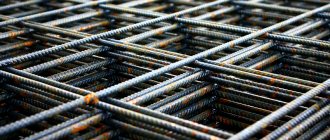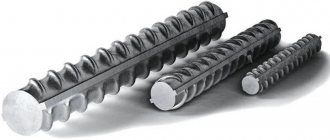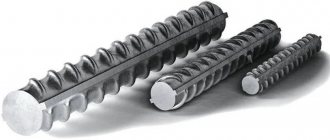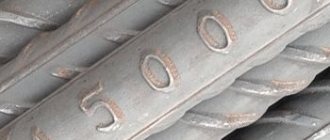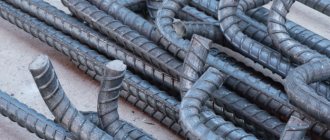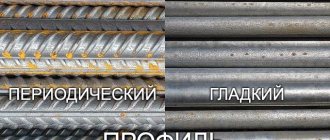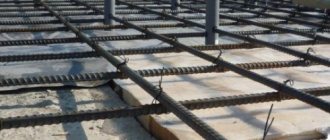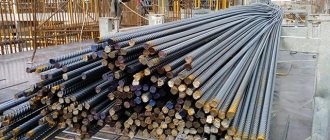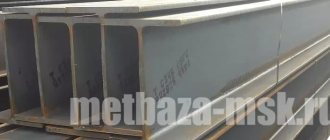In the capital construction of monolithic country houses one cannot do without reinforced structures. At the same time, the majority of costs in the process of purchasing materials mainly fall on fittings. To determine the quality of products, requirements for products according to various parameters, specially developed by Gosstandart, are used. In this type of production, standards are established for the diameter, weight and cross-section of rods. The weight of the reinforcement, calculated accurately and correctly, will help to realistically estimate not only the costs of organizing construction work, but also an important part of the cost of the entire facility. All these characteristics are united by one term - reinforcement range .
This article will tell you in more detail about the set of requirements. Metal corner: range, weight, characteristics, GOST standards (read more)
The reinforcement has established standards for cross-section, weight and diameter.
Scope of application, features of fittings: diameter, classes, markings, compliance with GOST
Reinforcement is an important component in the general list of building materials. It is characterized by a wide range of applications at various stages of building construction. Not a single reinforced concrete structure can do without it, serving as reinforcement and support both in the foundation of a small house and in the construction of a large-scale railway bridge or overpass. Reinforcement technology is even used to strengthen glass structures.
Reinforcement is used in construction at various stages of construction.
Even at the initial stage of developing design estimates, every self-respecting engineer and architect has at hand a special table of the ratios of weight and footage of reinforcement, as well as cross-sections of reinforcing bars in accordance with established state standards. The main one among them is GOST 5781-82. Also, products must comply with GOST 52544-2006, STO ASChM 7-93, TU 14-1-5254-94. The standards regulate the requirements for a specific type of reinforced products. Their totality corresponds to the term – reinforcement assortment.
The fittings are round metal rods with a smooth or corrugated surface. They are made from several types of steel. The diameter of the rods ranges from 4 to 80 mm. The product range is divided into classes A1 – A6.
I-beam: assortment, dimensions, technical characteristics of profiles (read more)
Diameter, that is, the cross-sectional size of a reinforcement bar or wire, is the main indicator underlying the product range. Hence the corresponding terms: reinforcement 8 mm or weight 1 m of reinforcement 12. These products are classified according to other properties, including strength, wear resistance, specific gravity and other characteristics, which we will consider further.
Calculation of the amount of reinforcement
Manufacturers supply reinforcement with a length of 11.7 m. The value is justified by the waste of the part itself when laying overlapping. The useful length in this situation is 10 m. The remaining part will go to the ligament elements with the adjacent whip. The approximate volume of blanks for a strip foundation 50 m long is 20 pieces.
If you need to calculate the total number of rods for the entire perimeter of the foundation, then you should add the amount of reinforcement for connections and lintels (vertical, horizontal). For example, in a building being constructed with 4 walls, 16 m of material will be required when laying 4 rods on one wall.
The use of reinforcement when constructing a foundation
The lintels are laid out at a distance of 0.5 m. The parameters of the reinforced frame lattice depend on the size of the foundation. A foundation with a height of 600 mm and a width of 350 mm implies a distance between the bars in the lattice equal to 500 mm and 250 mm, respectively. So, with a foundation perimeter of 50 m, 100 ring-shaped transverse connections are obtained (50:0.5=100), having a perimeter of 1.5 m (0.5*2+0.25*2). Then the total length of the rod will be 150 m (100 * 1.5). Taking into account waste, the total volume for lintels will be 157.5 m.
After calculating the volume of reinforcement, it is necessary to estimate the amount of wire for knitting elements in the strip foundation. The consumer can choose another knitting option - with a gun or welding.
The strength characteristics of reinforcing elements make it possible to build monolithic foundations, beams, arches and other important structures. The range of products is quite wide, which ensures a high-quality selection for individual objects. Knowing the parameters of the building or structure under construction, everyone can purchase fittings that are suitable in size and properties.
Reinforcement classes: product range by strength and mechanical parameters
The word assortment (or assortment) in French sounds like assortir and means “to select,” that is, to sort into varieties in accordance with typical characteristics.
Reinforcement differs in various parameters, such as dimensions, profile and material for manufacture.
These parameters include:
- material used to manufacture products;
- reinforcement dimensions, such as size, diameter, surface type;
- profile.
On a note! Products are packaged according to their diameter classification. Reinforcing metal products up to 10 mm are sold in coils, and above this parameter they are packaged in rods of a certain length.
Reinforcement is used in construction work in the form of rods, mesh, wire or frame. Based on its purpose, it is divided into structural, anchor, installation or working. This takes into account the presence or absence of tension, as well as the need to strengthen the structure in a certain area. Reinforcement can be longitudinal or transverse.
Reinforcement is also marked and classified according to other characteristic features, but first of all, the diameter of the reinforcement is taken into account, as well as the degree of strength, flexibility and mechanical characteristics. The symbol in the assortment marking is the capital letters A (less often B) with a certain index, which indicates that the reinforcement corresponds to a particular class. We will consider the main and most popular classes of reinforcement in construction in this article.
The fittings are divided into several classes, each of which has its own characteristics.
Rebar weight calculator
The KALK.PRO service invites you to use the online reinforcement calculator on our website - you will get the result! The calculator allows you to calculate the weight of reinforcement based on a known length (per meter), or, conversely, calculate how many meters are contained in a ton of reinforcement. The regulatory framework for performing the calculation is based on the tables of GOST 5781-82 (outdated) and GOST 34028-2016 (current). As a result, you will receive accurate results that allow you to use them when drawing up design estimates and placing a further order with a production organization.
If you need to determine the amount of reinforcement for foundation construction, we recommend using separate calculators:
- calculation of reinforcement for strip foundations;
- calculation of reinforcement for a monolithic slab.
All possible diameters of reinforcement are used in the calculations, such as 6, 8, 10, 12, 14, 16, 20, etc. If necessary, you can immediately use a metal grader or look at GOSTs in the corresponding tabs of the tool.
By default, the weight of 1 meter of reinforcement is calculated.
Calculation of reinforcement weight
- Select the metal type (default is Steel).
- Confirm the assortment type – Fittings.
- Select the calculation method – Weight calculation.
- Select a regulatory document - GOST 5781-82 / GOST 34028-2016.
- Specify the diameter of the reinforcement rod, mm.
- Enter the length of the rolled metal, m.
Converting reinforcement from tons to meters
- Select the metal type (default is Steel).
- Confirm the assortment type – Fittings.
- Select the calculation method – Length calculation.
- Select a regulatory document - GOST 5781-82 / GOST 34028-2016.
- Specify the diameter of the reinforcement rod, mm.
- Enter the mass of rolled metal, kg.
How to calculate the mass yourself?
You can determine the weight of the reinforcement yourself. For example, to calculate 1 linear meter you need to use the expression:
Reinforcement calculation formula: m = π × (D2 / 4) × ρ
- π – Pi number;
- D – reinforcement diameter, mm;
- ρ – steel density (7850 kg/m3).
Rebar weight table
| Diameter, mm | Meter weight, kg | Meters per ton |
| 0.222 | 4504.51 | |
| 0.395 | 2531.65 | |
| 0.617 | 1620.75 | |
| 0.888 | 1126.13 | |
| 1.21 | 826.45 | |
| 1.58 | 632.92 | |
| 2.00 | 500.00 | |
| 2.47 | 404.86 | |
| 2.98 | 335.58 | |
| 3.85 | 259.75 | |
| 4.83 | 207.04 | |
| 6.31 | 158.48 | |
| 7.99 | 125.16 | |
| 40 | 9.87 | 101.32 |
| 45 | 12.48 | 80.13 |
| 50 | 15.41 | 64.90 |
| 55 | 18.65 | 53.62 |
| 60 | 22.19 | 45.07 |
| 70 | 30.21 | 33.11 |
| 80 | 39.46 | 25.35 |
Reinforcement classes
| Reinforcing steel class | Profile diameter, mm | steel grade |
| AI (A240) | 6-40 | St3kp, St3ps, St3sp |
| A-II (A300) | 10-40 40-80 | St5sp, St5ps 18G2S |
| Ac-II (Ac300) | 10-32 (36-40) | 10GT |
| A-III (A400) | 6-40 6-22 | 35GS, 25G2S 32G2Rps |
| A-IV (A600) | 10-18 (6-8) 10-32 (36-40) | 80C 20ХГ2Ц |
| AV (A800) | (6-8) 10-32 (36-40) | 23Х2Г2Т |
| A-VI (A1000) | 10-22 | 22Kh2G2AYu, 22Kh2G2R, 20Kh2G2SR |
The table data is based on materials from GOST 5781-82 “Hot-rolled steel for reinforcement of reinforced concrete structures” and GOST 34028-2016 “Rolled reinforcement for reinforced concrete structures”.
Reinforcement assortment table: designations and characteristics of various classes
Even professionals sometimes get confused in construction terminology and markings. Different types of materials, including fittings, have their own classification, which makes it possible to simplify and unify many processes as much as possible.
What is a channel: range, characteristics, areas of application (read more)
A special table of reinforcement classes will help you navigate the classification and labeling. It has a fairly simple and understandable structure, consisting of several columns, where the first is the main marking, and then the corresponding characteristics:
- weight;
- section size or diameter;
- load resistance;
- integration into stressed reinforced concrete structures;
- relative elongation after rupture;
- rod length;
- steel grade.
Reinforcement class A240 has a smooth surface, cross-section from 6 to 40 mm.
The table may contain more extended information, for example, allowing you to calculate the weight of a linear meter of reinforcement or, conversely, calculate how many meters are in a ton of 12 mm reinforcement. For beginning builders, a simplified version with a minimum of background information is suitable.
Channel characteristics: channel weight, size table, cost of profiles (read more)
The class of reinforcement includes several digital and letter designations that determine its strength, size and purpose. At the same time, according to the reinforcement assortment table, GOST 5781 82 regulates old and new markings. The old ones include products belonging to classes from AI to AVI. Accordingly, the new one is designated as follows: A240, A300, A400, A500, A600, 800 and A1000.
Reinforcement class A240C has a smooth external structure, and products marked A300C, A400C, A500C, as well as A600, A600K, A800, A800K and A1000 have a corrugated surface.
On a note! There is a certain coding of the fittings, which looks like this: fittings A-400-C Ø12. Where the letter A denotes the marking of the material, the number 400 is the reinforcement class, 12 is the diameter of the rod.
A300 class reinforcement is used for the construction of low-rise buildings.
How much does a meter of reinforcement weigh and how many meters of reinforcement per ton: examples of calculations
Skills in calculating the diameter of the rods will also be needed when calculating the weight of the reinforcement. Such knowledge is necessary when drawing up projects and construction estimates. Accurate determination of the weight of the reinforcement will help you save on the purchase of materials
It is important to note the fact that large manufacturers sell reinforcement at a price of 1 ton, and not per meter. However, the cost of production in this case will be several times cheaper
As an example, we can consider how to calculate the mass of the necessary material for the construction of a reinforced concrete foundation with a total length of 100 m. The diameter of the reinforcement is 10 mm. We look for the necessary data in the table, they correspond to 617 g. We multiply this number by 100 and get 61 kg 700 g. The weight of 1 meter of reinforcement can be calculated in other ways (there are three in total):
- according to the normative table;
- using data on the specific gravity of reinforcement;
- using the reinforcement weight calculator.
Thanks to accurate calculations of the required weight of the reinforcement, you can save on the purchase of material
The required number of rods by standard weight is calculated using the above weight table in relation to the linear meter. This is the simplest calculation option (except for an online calculator).
For example, for construction it is expected to use 2300 m of reinforcement 14. The weight of 1 meter of rods is 1.21 kg. We make calculations: 2300 * 1.21 = 2783 kg. Thus, to complete this volume of work, 2 tons of 783 kg of steel rods will be required. The number of rods in one ton of the corresponding diameter is calculated in the same way. The data is taken from the table.
Explanation of the reinforcement table with characteristics of each class
Each class of reinforcement has its own characteristics, and many data may be the same for different types or vary radically. Their main parameters are given below.
AI or A240 - reinforcement, which is a smooth-bore rod with a cross section from 6 to 40 mm. It is used in the manufacture of reinforced concrete products, for the construction of monolithic and supporting structures. Reinforcement of any diameter is produced in rods and packaged. It is allowed to produce products with a cross-section of up to 12 mm in coils.
AII or A300 is a profile with a corrugated surface and a diameter from 10 to 80 mm. Belongs to materials that can withstand high pressure. They serve as the basis of the supporting structure, which experiences the main load. They are used in the construction of low-rise buildings, monolithic buildings and during renovations.
AIII or A400, A500 - reinforcing bars having a periodic profile with a cross-section from 6 to 40 mm. The most popular class of reinforcement for wide application in both residential construction and industrial or commercial construction. They are also used in the production of reinforced concrete products, in the construction of roads and sidewalks. Products with a diameter of up to 10 mm are produced in skeins, above this size - in rods.
a – smooth rod class A240; b – rod of a periodic profile of class A300; c – class A400 and higher; d – wire class B600.
AIV or A600 – rods with a diameter of 10-32 mm. They are used in the construction of stressed elements. The products are similar to class AIII products, but have a lower frequency of ribs.
AV or A800 is a rare range of reinforcement with a high degree of strength. They are used in the construction of especially large and super-heavy objects, such as bridges, piers, subways, and hydroelectric power stations.
A6 (A1000) – made from heat-resistant steel. Has an increased level of resistance to various types of deformation. Used in multi-storey construction.
Weight of reinforcement, how many meters in 1 ton?
During construction, it is necessary to have an accurate idea of how much weight the entire reinforced structure has as a whole. There are a number of reasons for this:
- This makes it possible to withstand reinforcement technology.
- Guarantees the necessary reliability of the structure.
- It is more convenient to calculate the total cost of the structure.
The greatest attention is paid to a rod with a diameter of 12 mm, because this is the minimum diameter value that can be used when creating structures for strip foundations
And of course, we should not forget about the significant factor that during construction, it is very important to know exactly how many meters of reinforcement will be required for one ton of planned products
How much does the reinforcement weigh and the amount of reinforcement per ton, table:
The weight of a meter of reinforcement is presented in the table of the ratio of diameter and weight of 1 m. Knowing the weight of reinforcing steel according to GOST 5781-82, you can estimate the reinforcement coefficient of the structure (the ratio of the mass of the reinforcement to the volume of concrete) and determine how much material is needed for the foundation (per cube of concrete)
A linear meter of reinforcement is individual reinforcing bars of a smooth and periodic profile 1 meter long, the weight of which depends on the diameter of the reinforcing steel GOST 5781-82 (from a range of diameter sizes of periodic steel - 6, 8.10, 12, 14, 16, 18.20, 22, 25, 28, 32, 36, 40, 45, 50, 55, 60, 70, 80 mm).
| Reinforcement size (nominal bar diameter) | Weight of 1 m of reinforcement, theoretical, kg | Number of meters of reinforcement in 1 ton, m. |
| 4 | 0,099 | 10101,010 |
| 5 | 0,154 | 6493,506 |
| 6 | 0,222 | 4504,504 |
| 8 | 0,395 | 2531,645 |
| 10 | 0,617 | 1620,745 |
| 12 | 0,888 | 1126,126 |
| 14 | 1,210 | 826,446 |
| 16 | 1,580 | 632,911 |
| 18 | 2,000 | 500,000 |
| 20 | 2,470 | 404,858 |
| 22 | 2,980 | 335,570 |
| 25 | 3,850 | 259,740 |
| 28 | 4,830 | 207,037 |
| 32 | 6,310 | 158,478 |
| 36 | 7,990 | 125,156 |
| 40 | 9,870 | 101,317 |
| 45 | 12,480 | 80,128 |
| 50 | 15,410 | 64,892 |
| 55 | 18,650 | 53,619 |
| 60 | 22,190 | 45,065 |
| 70 | 30,210 | 33,101 |
| 80 | 39,460 | 25,342 |
Judging by this table, 1126 meters of reinforcement with a diameter of 12 mm equals one ton of product. Using this table you can also find out the length of the reinforcement in one kilogram and its weight in one meter of all sizes.
These values will be useful to you when using a metal rod directly if, for example, you need to know what the mass of all the reinforcement used in the construction of a building is. To do this, you just need to add up all the lengths of the reinforcing bars and then multiply the sum by the weight of 1 p/m.
It should be noted that 10 mm reinforcement still exists and is used when pouring foundations. But this occurs only in transverse, that is, in auxiliary reinforcement. In addition to these factors, we should not forget that only those rods that are marked with the symbol “C” are subject to welding. This whole long process is necessary, since during construction it is necessary to know the length of the reinforcement, and when purchasing it, mass (weight) is important.
Diameters of fittings according to GOST 5781-82
| Reinforcing steel class | Profile diameter, mm |
| A-I (A240) | 6-40 |
| A-II (A300) | 10-80 |
| Ac-II (Ac300) | 10-32 (36-40) |
| A-III (A400) | 6-40 |
| A-IV (A600) | (6-8) 10-32 (36-40) |
| A-V (A800) | (6-8) 10-32 (36-40) |
| A-VI (A1000) | 10-22 |
| The dimensions indicated in brackets are manufactured by agreement between the manufacturer and the consumer. |
Diameters of fittings according to GOST 5781-82
| Reinforcing steel class | Profile diameter, mm |
| А500С | 6-40 |
| В500С | 4-12 |
Do not forget that the number of rods per ton can vary, because this directly depends on their length. For example, much fewer rods 10 meters long will be needed than rods with the same diameter but 2 m long.
A500S fittings: GOST, key parameters and characteristics
Since the third category is the most common, which class of reinforcement (A400 or A500) to choose is up to the designers, who take into account all the nuances of construction work. Speaking about the structural features of this type, you should pay attention to GOST reinforcement A500. It regulates the production of a round profile having two ribs along the rod and parallel rows of crescent-shaped protrusions across. Moreover, they do not intersect with paired ribs along the body of the rod.
Reinforcement class A500 is the most universal, it is produced in coils and rods.
The profile has high ductility and strength characteristics during the rolling process. A500 reinforcement bars have a minimum length of 6 m, and a maximum length of 25 m. The optimal length of the rods is 12 m. According to the assortment table, A500S reinforcement is made from high-quality marked steel St3SP, St3PS and St3GPS. The material has excellent weldability, but this is not its only advantage.
On a note! A500C fittings can be connected using electric arc welding machines. This advantage is indicated by the letter C in the profile marking. The quality of welding is reduced by the minimum presence of alloying elements.
The positive properties of such fittings are as follows:
- increased degree of strength and flexibility, absence of weak points that could lead to destruction of the reinforcement;
- relatively low production cost and, as a consequence, affordable cost of reinforcement per ton;
- the specific gravity of A500 reinforcement implies significant savings in steel volumes during the manufacturing process.
Class A500 is used not only in residential construction, but also in commercial and industrial construction.
Docking reinforcement using the knitting method
This is the easiest way to ensure a reliable rebar structure. For this work, the most popular class of rods is used, namely A400 AIII. The overlapping reinforcement connection without welding is performed using a binding wire. To do this, two rods are placed next to each other and tied in several places with wire. As mentioned above, according to SNiP, there are 3 options for fixing reinforcing bars with viscous. Fixation with straight ends of a periodic profile, fixation with straight ends of the transverse type, and also using parts with bends at the ends.
It is absolutely impossible to connect reinforcement bars with an overlap. There are a number of requirements for these connections so that they do not become the weak point of the entire structure. And it’s not just about the length of the overlap, but also other points.
Important nuances and requirements for viscous connections
Although the process of connecting rods using wire is simpler than connecting them with a welding machine, it cannot be called simple. Like any work, the process requires strict adherence to rules and recommendations. Only then can we say that the reinforcement of the monolithic structure is done correctly
When connecting reinforcement with an overlap using the knitting method, you should pay attention to the following parameters:
- rod cover length;
- location of the connection point in the structure and its features;
- how the overlaps are located one to the other.
We mentioned that it is impossible to place an overlapping reinforcement joint in an area with the highest degree of load and stress. These areas also include the corners of the building. It turns out that you need to correctly calculate the joints. Their location should be in areas of the reinforced concrete structure where there is no load, or where it is minimal. What to do if it is technically impossible to comply with this requirement? In this case, the size of the overlap of the rods depends on how many diameters the reinforcement has. The formula is as follows: the size of the connection is equal to 90 diameters of the rods used. For example, if Ø20 mm reinforcement is used, then the overlap size in the area with high load is 1800 mm.
However, technical standards clearly regulate the dimensions of such connections. The overlap depends not only on the diameter of the rods, but also on other criteria:
- class of fittings used for work;
- what grade of concrete is used for pouring concrete;
- what is a reinforced concrete base used for?
- degree of load applied.
GOST requirements: B500 fittings, features of its manufacture
A500C reinforcement is successfully used in compressed elements. At the same time, the quality of concreting increases due to a reduction in the number of metal structures in the columns. Profiles can be used in projects where sections of classes АІ and АІІІ are specified. An analogue of the universal fittings A500C can be the fittings B500.
The B500C fittings meet European standards in terms of the chemical and technological characteristics of the raw materials and structure. The main advantage is flexibility. The high degree of plasticity of reinforcement structures prevents the destruction of buildings. Reinforcing products of this class in the Russian Federation are produced in accordance with GOST R 52554. They are intended for the construction of structures made of lightweight and weighted concrete.
Such buildings are used in aggressive environments. Reinforcement is used both in the form of independent rods and in frames and welded products. According to its characteristics, B500С is an effective substitute for fittings marked A400, A400C, A240. The B500С fittings have the following basic parameters:
Class B500 fittings meet all European standards.
- is produced in accordance with European Union standards, which makes it possible to use it on European equipment;
- does not curl due to the absence of stripes;
- elongates by 1.4%, withstanding loads over 3%;
- characterized by excellent weldability.
As for the pricing policy, it is different and depends on the characteristics of the fittings and the volume of required products.
Composite reinforcement
Composite reinforcement is a modern alternative to steel analogues, which have long been used in monolithic construction. Its development began back in the 60s of the last century. In Russia it is produced in accordance with the requirements of GOST 31938-2012. In other countries, the international standard ISO 10406-1:2008 is used as a basis.
Classification of composite reinforcement
The starting materials for the production of composite reinforcement are carbon, glass, and fibers based on natural minerals. They form a strong rod, which is given a ribbed shape in various ways. Parts acquire strength and hardness as a result of high-temperature treatment.
Based on material design, non-metallic fittings are divided into several categories:
1. Fiberglass composite reinforcement (FFR) is a product of a combination of fiberglass (glass roving) with special resins. The fibers are obtained by drawing a molten aluminoborsilicate mixture to a thickness of about 10-20 microns. They are used to form rods of larger diameter using adhesive impregnations and resins.
ASK fittings.
2. Basalt-composite reinforcement (BCR) is obtained from molten mountain mineral - basalt. It is brought to a molten state, stretched to the state of the finest fibers. They are woven in the presence of organic resins into fairly thick rods that, when hardened, can withstand extreme loads.
ABK fittings.
3. Combined composite reinforcement (AKK) consists of fiberglass rods coated on the outside with basalt-plastic winding. It is somewhat inferior in strength characteristics to basalt rods, although it is often passed off as them by unscrupulous suppliers.
ACC fittings.
4. Carbon composite reinforcement (ACF) is made from carbon fibers 3-15 microns thick, laid parallel to each other. This material has very high tensile strength, but is more expensive than other composite analogues.
5. Aramidocomposite rods (AAC) are durable and chemically resistant parts made from polyamide molecular chains. The hydrogen bonds that arise between them during the molding process give the products special reliability and durability.
Dimensions of composite reinforcement
Composite reinforcement, even with a small thickness, can take on enormous loads. The most popular diameters of such rods are presented in Table No. 4.
Table 4. Nominal diameters of composite reinforcement
| Nominal diameter according to GOST 31938-2012 Composite polymer reinforcement for reinforcing concrete structures. General technical conditions (with Amendment), mm | ||||||||||||
| 4 | 6 | 8 | 10 | 12 | 14 | 16 | 18 | 20 | 22 | 25 | 28 | 32 |
The standard allows the production of composite reinforcement with other sizes. The rods usually arrive from the manufacturer in a strictly defined cut. Their length ranges from 0.5 to 12.0 meters. Maximum deviations in the length of single copies cannot exceed the values specified in table No. 5.
Table 5. Requirements for the manufacturing accuracy of composite rods
| Rod length | Maximum deviations along the length, mm |
| up to 6 meters inclusive | +/- 25 |
| over 6 to 12 meters | +/- 35 |
| more than 12 meters | +/- 50 |
Some types of composite rebar come in the form of coils or wound on rigid drums.
Coil of composite reinforcement.
Profile type
Composite reinforcement cannot be made completely smooth. For better contact with the concrete mixture, it is given a relief profile.
He can be:
1. Conditionally smooth. The main fiberglass rod of constant cross-section is covered with a topping of fine-grained quartz sand firmly bound to the base.
Fiberglass reinforcement with sand coating.
2. Periodic. A fiberglass strand is tightly wound around the central rod, giving the surface a regular helical structure.
Composite reinforcement with periodic corrugation.
Reinforcement range: additional marking options
To determine more specific characteristics of the reinforcement, a special additional marking system has been created. For example, the abbreviation A5K means that these are class A5 profiles, and the letter K indicates the presence of additional corrosion protection. To do this, the material is treated with special agents that ensure its durability.
The presence of the letter C in the marking indicates that the reinforcement can be welded. It must be taken into account that not all products belonging to different classes can be welded together, especially in the absence of the C mark in the designation.
If the marking contains the letter K, this means that the reinforcement has additional corrosion protection.
Speaking about the range of fittings, we should mention such a term as shut-off (or pipeline) valves. These types of profiles are used in plumbing work. Accordingly, as a separate subtype of material, this reinforcement has its own classes and markings. In this case, the main parameter of choice is tightness. This criterion indicates the quality of the assembly in the pipeline, without which it is impossible to assemble it. The tightness indicator is indicated in the characteristics on the packaging of the material.
On a note! It is better to connect reinforcing bars with different markings and in the absence of the letter C in the designation, using special couplings and wire.
